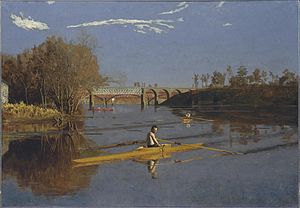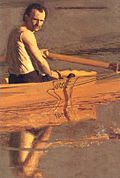Max Schmitt in one

|
| Max Schmitt in one |
|---|
| Thomas Eakins , 1871 |
| Oil on canvas |
| 82.6 x 117.5 cm |
| Metropolitan Museum of Art |
Max Schmitt in One (English Max Schmitt in a Single Scull , or The Champion Single Sculls or The Champion, Single Sculls ) is an oil painting by Thomas Eakins, completed in 1871 . The portrait of his German-born childhood friend Max Schmitt is the first and, according to critics, best known and best of his rowing pictures.
Shortly after its completion, the picture was shown once for four days in the location Philadelphia . It has only been open to the public again since it was acquired by the Metropolitan Museum of Art in New York in 1934 , to whose permanent collection it has been since then.
Milton Brown sees a new quality in the choice of motif. Although its aesthetics are rather backward, the subject is new. Sports pictures were part of the lower, folk art at this time.
description
In Philadelphia in the late 19th century that was rowing widespread in the population sport. Eakins and Schmitt were also active rowers.
The venue for regattas of the local rowing clubs (the so-called Schuylkill Navy ) was the Schuylkill River .
The painting shows Max Schmitt in a single in the foreground of the picture. Schmitt looks over his shoulder out of the picture. The side of his boat is labeled Josie (after Schmitt's sister). As the alternative name of the painting (The Champion, Single Sculls) suggests, Schmitt is shown resting after a successful race. It is believed to represent Schmitt's victory on October 5, 1870. Afternoon is given as the time of day.
In the center of the picture, Eakins has also depicted himself in a one. Eakins' signature can be found on the back wall of the boat. He rows away from Schmitt.
The Pennsylvania Railroad Connecting Bridge and Girard Avenue Bridge can be seen in the background . In front of the bridges you can see an ancient, in contrast to the very light ones, heavy barge, behind the bridges a steamboat.
During the time shown, rowing boats with movable seats became more and more popular. However, it cannot be inferred from the literature whether Schmitt and Eakins used boats equipped in this way.
Emergence
Eakins is known to be very careful about correct perspective . Preserved sketches and drawings suggest that Eakins was very methodical with this painting as well. It is known of some paintings that he made perspective drawings on a scale of 1: 1 and then transferred the essential perspective features to the canvas by pricking.
As with the other works of Eakins, he worked with a photographic precision; Nevertheless, it can be assumed that Eakins has not yet worked with photographs as a template; he did not acquire his first camera until 1880. Later works show that he worked with wax dolls and models.
Classification in the overall work
Eakins returned from his education from Europe in 1870. His first works after his return were conventional portraits of family and friends. Soon afterwards he began to paint rowing pictures, which (apart from the painting A Street Scene in Seville, which was still made in Europe ) represent the beginning of a series of open-air pictures , one of which is Swimming . The rowing pictures comprise a total of six oil paintings and five watercolors and were completed between 1871 and 1874. Eakins never took up the subject of rowing again, but continued to paint various outdoor pictures of various kinds. Outdoor scenes no longer appear in Eakins' late work.
reception
The four-day exhibition of the picture in Philadelphia in April 1871 led to different reactions. Two Philadelphia-based newspapers mention the painting in their coverage. The Philadelphia Bulletin is positive:
“The latter artist, who has lately returned from Europe and the influence of Gérôme, has also a picture entitled 'The Champion Single Sculls' (No. 137), which, though peculiar, has more than ordinary interest. The Artist, in dealing so boldly and broadly with the commonplace in nature, is working upon well-supported theories, and despite a somewhat scattered effect, gives promise of a conspicuous future. "
“The latter artist, who has recently returned from Europe and under the influence of Gérôme , also shows a picture called 'The Champion Single Sculls' (No. 137) which, although peculiar, arouses more than usual interest. The artist, who confidently and extensively deals with the ordinary in nature, works with well-supported theories, and despite a somewhat undecided impression, he promises a remarkable future. "
The Philadelphia Inquirer, however, sees Eakins' work in a more critical light:
“Thomas Eakins shows two, a portrait and a river scene, entitled 'The Champion Sculls'. While manifesting a marked ability, especially in the painting of the rower in the foreground, the whole effect is scarely satisfactory. The light on the water, on the rower and on the trees lining the bank indicates that the sun is blazing fiercely, but on looking upward one perceives a curiously dull leaden sky. ”
“Thomas Eakins is showing two [works], a portrait and a river scene, titled 'The Champion Sculls'. It does show clear skills, especially with the rower in the foreground, but the overall effect is not very satisfactory. The light on the water, on the oarsman and on the trees that line the shore indicates a fiercely flaming sun, but looking up you can see a strangely cloudy, leaden sky. "
Since the painting was not shown publicly for the next 59 years, there are no further contemporary reviews. In the first biography of the art historian Lloyd Goodrich, published in 1933, he mentions the painting without emphasizing it.
The picture became known to a larger German public in the early 1980s through its inclusion in the series 100 masterpieces from the great museums of the world , where it was touted as the best known and best oar painting by Eakins.
Alice A. Carter writes about Eakins 'rowing pictures, pointing to Eakins' particular knowledge of human anatomy:
"His portraits of half-clad athletes caught in mid-action became a vehicle for his extraordinary understanding of anatomy."
"His portraits of half-dressed athletes in motion became a vehicle for his outstanding understanding of anatomy."
In his volume of poetry, The Mystery of Max Schmitt , Philip Dacey addresses the painting in one of the poems. Dacey laments the coming commercialization of rowing and describes the content of the painting in verse.
Identity of the sitter
Max Schmitt (* 1842; † 1900) and Eakins had been friends since they went to school together. They were classmates in both elementary school and Philadelphia's Central High School . Eakins learned the German language from Schmitt, who was of German origin. In addition to rowing, Schmitt was also interested in boxing, as Eakins mentions in a letter: Max Schmitt taught me a little about boxing, which I have forgotten. Schmitt was a lawyer by profession.
In contrast to Eakins, Schmitt was a soldier in the American Civil War . By the time the painting depicts, Schmitt had been a local amateur rowing champion for several years.
Provenance
The painting was exhibited in the Union League of Philadelphia in 1871 under the name The Champion Single Sculls . It was owned by Max Schmitt until his death in 1900. It was then owned by Schmitt's widow Louise SM Nache until 1930, then by Eakins' widow Susan Macdowell Eakins until 1933. From 1930 to 1931 it was offered in the Babcock Galleries in New York, in 1934 in the Milch Galleries also in New York. The painting was then acquired by the Metropolitan Museum of Art in 1934 with funding from The Alfred N. Punnett Endowment Fund and George D. Pratt .
literature
- Wibke von Bonin (Ed.): 100 masterpieces , Volume 1, vgs, Cologne, 1983, ISBN 3-8025-2161-7 , pp. 316–321.
- Helen A. Cooper: Thomas Eakins The Rowing Pictures, Yale, New Haven, 1996, ISBN 0-300-07785-8 .
Web links
- Entry on Max Schmitt in the Eine at the Metropolitan Museum of Art
- Gordon Hendricks : The Champion Single Sculls
- Meg Floryan: Max Schmitt in one at smarthistory.khanacademy.org
- Ian Gordon: Max Schmitt in the one at picturinghistory.gc.cuny.edu
- Rowing pictures at xroads.virginia.edu
Remarks
- ↑ a b The Pennsylvania Academy of the Fine Arts (PAFA) built a new building at this time and therefore suspended its regular exhibitions. Instead, a total of three exhibitions took place in the Union League of Philadelphia . Max Schmitt in the one was exhibited in the last one.
- ↑ The portrait, owned by MH Messchert, can no longer be identified today.
Individual evidence
- ↑ a b c 100 masterpieces, Milton Brown, p. 317.
- ↑ Sidney D. Kirkpatrick: The Revenge of Thomas Eakins, Yale University Press, New Haven & London, 2006, ISBN 0-300-10855-9 , p. 140.
- ^ Lloyd Goodrich: Thomas Eakins His Life and Work, Whitney Museum of American Art, New York, 1933.
- ↑ Alice A. Carter: The Essential Thomas Eakins, Harry N. Abrams, New York, 2001, ISBN 0-8109-5830-9 , p. 34.
- ↑ Philip Dacey: The Mystery of Max Schmitt, Poems on the Life and Work of Thomas Eakins, Turning Point, 2004, ISBN 1-932339-46-9 , pp. 43-45.
- ^ A b William Innes Homer : The Paris Letters of Thomas Eakins, Princeton University Press, Princeton, 2009, p. 27, 3rd footnote, ISBN 978-0-691-13808-4 .
- ^ William S. McFeely: Portrait The Life of Thomas Eakins, WW Norton & Company, New York, 2007, ISBN 978-0-393-05065-3 , p. 28.
- ↑ Helen A. Cooper, p. 136.








